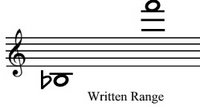The Bb and Eb family and the rarer the C and F family. The Bb and Eb instruments are commonly used. The four most common are the Bb soprano, the Eb alto, Bb tenor, Eb baritone. Other instruments in this family include Eb sopranino (which is an octave above the Eb alto sax), the Bb bass saxophone (which is an octave below the tenor saxophone), and the Eb contrabass saxophone (which is an octave below the baritone saxophone).
The saxophones pitched in C and F are not used in bands or as solo instruments. The C melody saxophone is used sometimes in rock bands for players who don't want to transpose parts. But the C/F family can be found in quartet groups. The reason for these horns not being used as much is their intonation. The player spends more time trying to play in tune then they do playing musically.
 The written range of all saxophones are Bb below middle C to an F three ledger lines above the treble staff. Some saxophones, namely the intermediate and professional line, have keys that allow the saxophone to play up another half step (F# three ledger lines above the treble staff). Also some soprano saxophones have another key yet that will allow them to play a G four ledger lines above the treble staff!
The written range of all saxophones are Bb below middle C to an F three ledger lines above the treble staff. Some saxophones, namely the intermediate and professional line, have keys that allow the saxophone to play up another half step (F# three ledger lines above the treble staff). Also some soprano saxophones have another key yet that will allow them to play a G four ledger lines above the treble staff!When transposing the saxophone this is how you go about doing so. Let's start with the Bb soprano. When playing a C on the saxophone, the sounding pitch or the note that is sound on the piano is a Bb. So if you want to transpose a C part and you are playing a Bb instrument you must go up a M2 (major second) or 2 half steps. Since the instrument sounds M2 down you must play a M2 up to make the pitch sound the same. You use the same process for the Bb tenor however for the tenor it will sound an octave lower.
To transpose an Eb alto sax you must play a M6 or 9 half steps below written. I will also suggest to play up a m3 (minor third) or 3 half steps and having the sound be an octave lower than the piano.
